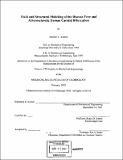Fluid and structural modeling of the disease-free and atherosclerotic human carotid bifurcation
Author(s)
Younis, Hesham F. (Hesham Farouk)
DownloadFull printable version (19.78Mb)
Other Contributors
Massachusetts Institute of Technology. Dept. of Mechanical Engineering.
Advisor
Roger D. Kamm.
Terms of use
Metadata
Show full item recordAbstract
Cardiovascular disease is the leading cause of death in the United States. It claims more lives each year than the next 7 leading causes of death combined. Atherosclerosis is a major cause of cardiovascular disease and is an inflammatory process characterized by intimal thickening of arteries and plaque build up. Atherosclerosis can also damage the arterial wall and in turn cause the formation of a thrombus that can partially or totally occlude the diseased artery. If the actual vessel is the carotid artery, this often leads to a stroke. The focus of this study is to analyze the blood flow and arterial wall motion in the carotid bifurcation, a frequently diseased site of the cerebral circulation. Using ultrasound velocity measurements and magnetic resonance imaging (MRI) data of normal volunteers and patients in vivo, realistic blood velocity profiles and wall anatomy geometries are generated and imported into a commercial finite element package, ADINA (Automatic Dynamic Incremental Nonlinear Analysis, Watertown, MA) for computational analysis. Using three types of 3D transient finite element analyses: structure only, rigid walled fluid only and fully coupled fluid-structure interaction, areas of low fluid shear stress and high mechanical strain are identified. These results are compared with experimental evidence collected from the literature as well as histological data of plaque gathered from imaged patients after endarterectomy to identify potential correlations with regions of inflammation. (cont.) In normal volunteers, localized high cyclic strains (which have been implicated in the stimulation of endothelial and smooth muscle cells) and high maximum wall shear stress temporal gradients (which are related to the expression of atherogenesis-related genes in endothelial cells) are observed at the flow divider and along the outside wall of the external carotid, both common sites of early inflammation. Localized separated flow regions are observed, especially near the outer wall of the internal carotid (the carotid bulb), in response to the localized abrupt changes in the curvature and cross-sectional area of the artery wall. The oscillation and low mean value of wall shear stress in these regions have been widely correlated to atherogenesis and late stage atherosclerotic inflammation. Within the 4 patients studied (P1, P2, P3 and P4), the results indicate that strong correlations exist in the vicinity of the carotid bulb, immediately downstream of observed stenoses, although the sign of the correlation coefficient seems to depend on the severity of the stenosis. The results in the two patients (P1 and P2) with non-constricting ( < 50%) stenoses, show that the wall shear stress (oscillatory shear index) in P1 at that location generally observes strong negative (positive) correlations with smooth muscle cell (SMC), lipid and collagen presence, but no correlation to macrophage presence and vice versa in P2, which experiences solely strong correlations with macrophage presence. This is evidence that the inflammatory process, is continuing downstream of the stenosis ...
Description
Thesis (Ph. D.)--Massachusetts Institute of Technology, Dept. of Mechanical Engineering, 2002. Includes bibliographical references.
Date issued
2002Department
Massachusetts Institute of Technology. Department of Mechanical EngineeringPublisher
Massachusetts Institute of Technology
Keywords
Mechanical Engineering.